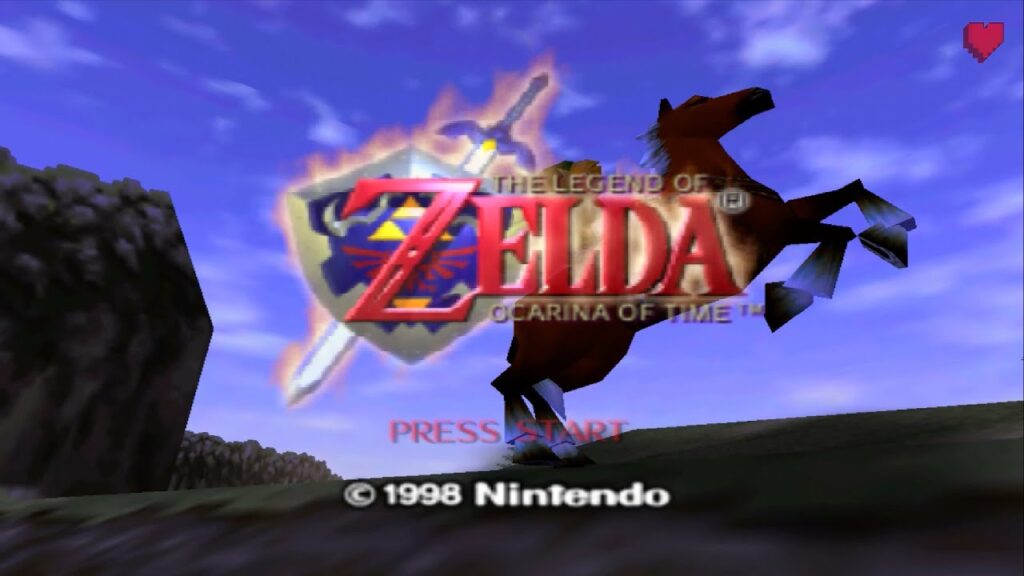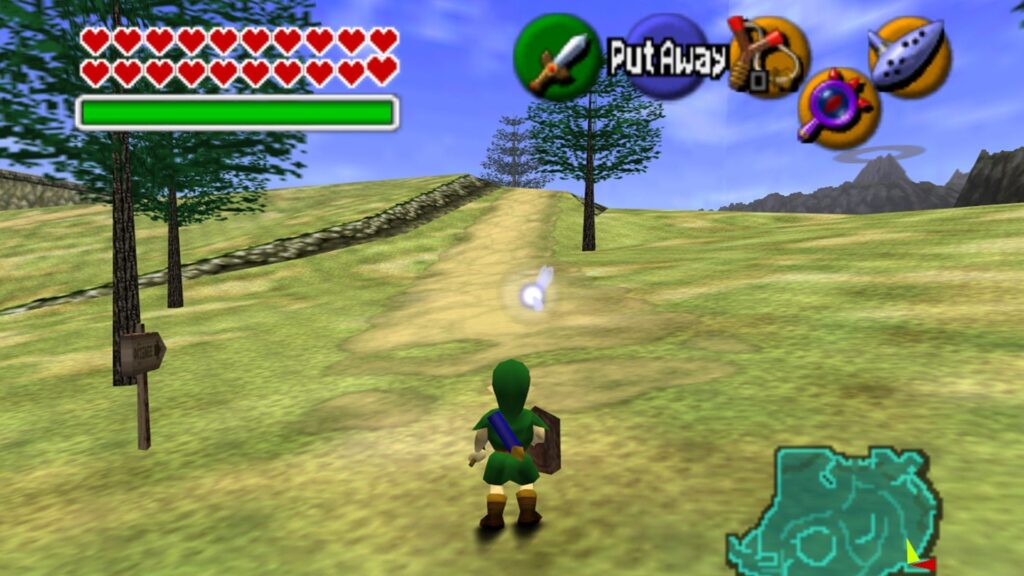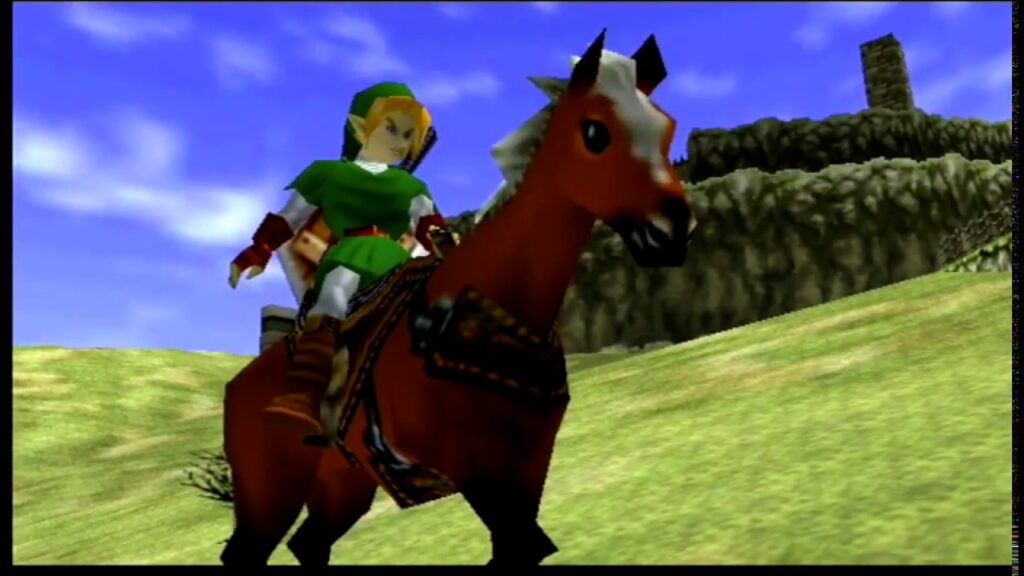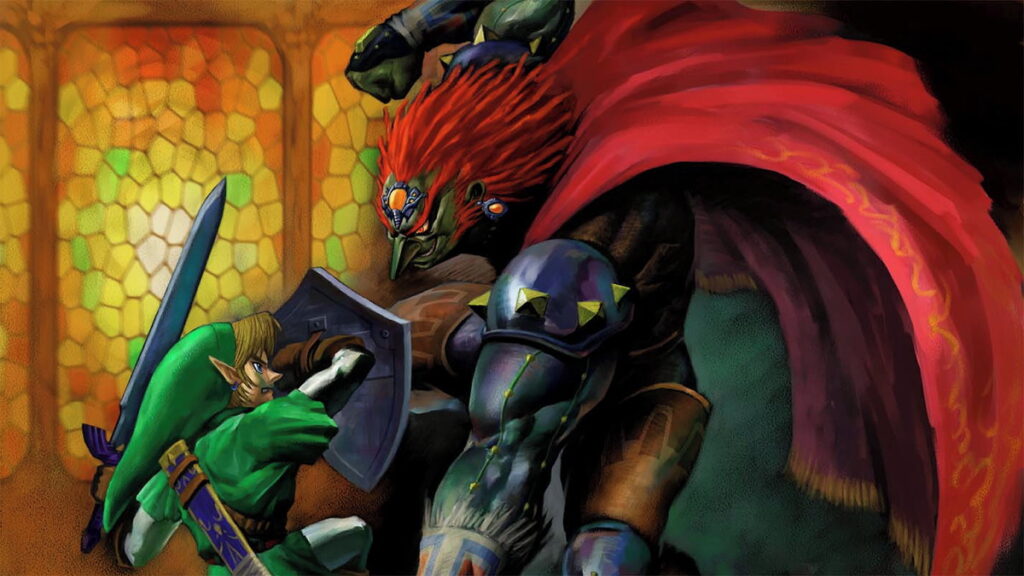Note: This is a review-like reminder of great games of old, as I have experienced them in the past and how they grew on me over the years. There may be minor spoilers.
The Legend of Zelda: Ocarina of Time is often praised as a great game, as the best of its generation, and even claimed as the best of all time. Those people are right, definitely right, but they usually miss one important detail: playing that game in 1998 was perhaps the highest privilege in videogame history.
Understand this, there were many great games released in the past two decades. We had the master of button-mashing action with God of War 2 back in the Playstation 2, we sweet-talked our allies in the masterful Mass Effect 2, and we shot realistic bandits in the wild west of Red Dead Redemption 2. None of those games, however, delivered the same step up than The Legend of Zelda: Ocarina of Time did. In fact, none of them could even compare to what the Nintendo team and Shigueru Miyamoto did back in 1998.
The younger generation may not know, but the late 90’s had perhaps the greatest transition of concepts in the history of the videogame industry. Suddenly, after developers somewhat mastering the art of 2D sprites in gaming, everything needed to be in 3D. Everyone demanded it. It was a necessary step forward in order to follow the aging players and welcome a new generation. It was nothing like the experience Microsoft made with Kinect or even how Virtual Reality is being inserted today. No, we had to have games in 3D. Period.
Many cherished franchises tried their hands in that regard. Some were conservative in order to be successful, such as Square’s Final Fantasy franchise, which only basically swapped 2D sprites with 3D models and worked around perfecting what they already knew. Those who tried big jumps, however, mostly failed, delivering clunky games with horrible controls and confusing cameras and maps, such as Prince of Persia, Altered Beast, and even Castlevania.
Nintendo, however, seemed to have understood the 3D games better than anyone else at that time and, after trying the ropes with Star Fox for the SNES and crafting the amazing Super Mario 64, they were ready to truly explore this new technology with another of their franchises. The Legend of Zelda: Ocarina of Time was not simply another testing of new grounds though, it existed to turn the videogame industry upside-down.

Not a simple transition
The Legend of Zelda: Ocarina of Time had the job to translate the series’ puzzles, tools, combat, and bits of RPG elements to a 3D world in a time no one exactly knew how to do that. There was barely a benchmark to compare, as games like Tomb Raider were far from masterful attempts at these elements. In fact, most 3D games by then had only barely succeeded in giving a new perspective for gameplay. There were massive issues with camera, movement, and sense of depth plaguing even the most important developing teams at the time.
What happened in late 1998, however, was not just a transition of a franchise to this new 3D world. No, The Legend of Zelda: Ocarina of Time released to completely obliterate many of those massive issues and set a standard that would redefine game development in the decades to come.
Camera
Pick the camera, for example. Third-person games are the nightmares to most developers even today, as the camera is an entity that is hard to program in a way that it behaves like it should. A vast amount of first-person games is not entirely due to a “game design” choice. Nope, it is that popular because it is much easier to program as the player becomes fully responsible for controlling the camera.
The Legend of Zelda: Ocarina of Time released in a time where a right analog stick was still crawling within the Playstation Dual-Shock, yet, what it does with its camera is amazing even today. There are plenty of reasons on why it works: the maps are small; there is a reset button to the camera; it slowly positions itself behind Link as he walks, with an important lagging effect to it; there are first-person perspectives to look around; and it is helped by one of the game’s greatest contribution to the industry, the Z-targeting.

There’s a lot of new stuff
Today we may take for granted many things when playing a third-person adventure game, even other Zelda games such as Breath of the Wild. Back in 1998, however, those things were groundbreaking developments created or perfected by Nintendo’s team. Yes, some were “perfected“.
Take the Z-targeting for example. You look at an enemy, hold the Z button and bang, combat just gains a new dimension with backflips, side-jumps, rolls, jumping attacks, and much more. If you pick any modern game with the same system you will notice that none of them do more than what Ocarina of Time already did back then. It’s easy to understand though: there’s not much to add anyway.
There’s also the contextual A-button, a stuff we really take for granted today but that was the opening ground to a whole new world. You see, most games before the 3D era had hard-coded buttons that did one thing and one thing only. At most, two buttons acted as “confirm” and “cancel” during dialogues or menus, otherwise they had only a single function such as jump, attack, open menu, change equipment, etc. The Legend of Zelda: Ocarina of Time, introduced the super context-sensitive A button, whose function depended entirely on where and what Link was doing. If he was mounted on a horse (yes, Ocarina of Time did that too) it would boost speed, if he was close to an object he would interact with it, if he was fighting it would make him roll and dodge, and so on. Simple today, right? Not so much two decades ago.
The exploration part was also a big step up, mostly because of its combination of camera options, lightning effects, and tools. You could look around to see hidden elements, the shadows and light offered not simply new ways to work on puzzles, but also gave a depth to the scenarios which made it easier to locate yourself and the pieces you had to interact with. Every nook had something awaiting discovery, requiring you to think which tool would be the correct one to use.

Really a lot
Hell. The Legend of Zelda: Ocarina of Time already had a day-night cycle back then, full with undead popping around and quests requiring a certain time of the day to be triggered. It had horse riding, it had swimming, it had some climbing, great fishing mini-game, and most importantly, the puzzles were amazing.
Yeah, amazing. The Legend of Zelda: Ocarina of Time, once again, not simply picked old puzzles and made it in 3D. No, it mastered those puzzles right away. Sliding rocks, special arrows, burning torches and webs, timed-puzzles, water puzzles. Damn, every tool you picked during the game worked for a new kind of puzzle such as the boomerang, the hookshot, and even the gauntlets.
If you play any Zelda game released after that, even Breath of the Wild, you can easily see that they offer nothing new there, nothing. Why? Well, because you cannot make the perfect better. In fact, when the new games in the franchise tried to change parts of those tools, puzzles, and mechanics, they mostly made it worse and had to go back to the way it was during Ocarina of Time. Very few other games managed to bring new dimensions to the 3D puzzle tools since then, such as Portal.
It is massive too
Well, the game certainly does not have that ridiculous giant map from Breath of the Wild, Skyrim, Assassin’s Creed: Odyssey, or Red Dead Redemption, but still offers a lot to do in it. The Hyrule Field became the benchmark of open-world area for a video game for years ahead, with similar iterations of it showing up in games like Final Fantasy X with its Calm Lands, Assassin’s Creed with its city-connecting hub, and many others.
The Legend of Zelda: Ocarina of Time, however, explored Hyrule in every way possible, going from the Death Mountain and its volcano-inspired dungeon to the Zora’s Domain and the incredible Water Temple. It picked the elements of the franchise and put them in a world that felt complete even if not ridiculously big. In fact, its size was just perfect, as every corner was used for something, hid a secret, a chest, some crazy new NPC, a new tool, ammunition, a heart piece, or anything else. It had no empty space just taking up your time to walk from point A to B, what it had, it used.

It became legendary
The result of all those innovations and technical improvements was a game that had almost no faults to it. One may claim the tale is quite simple but, once again, there were no competitors back in 1998 on the atmosphere and dimension of that game. Its tale offered real-time cutscenes to tell its stories, with darkness and shadows becoming big factors into turning the adventure into the unknown in something where caution was demanded and you would explore the world step-by-step instead of just running right through and slashing enemies.
There are plenty of memorable scenes in the story. Link starts out as the young silent protagonist who has a vision of great evil, and from there he travels the world in the shadow of Gannondorf, reaching places and acquiring the spiritual stones just moments after the people were already doomed. It is a dark atmosphere of incoming disaster where Link cannot be an immediate hero, and every tool in the game works in favor of making this trip feel like that.
Perhaps its most intriguing element, story-wise, is the fact that Link really cannot conquer the enemy before it is too late, so his only path is taking the Master Sword and speed through to the future, where he becomes a young adult capable of much more heroic deeds. In adult form, Link takes on a world that has already met its end, dominated by evil and darkness as Gannondorf rules supreme in Hyrule.
You, however, are not stuck with adult Link though. You can switch back to the past at any time. In fact, you must do so in many portions of the game, as some puzzles can only be solved by using both child and adult Link. This swap between time periods adds a complete new dimension to the game, both story-wise and in its puzzles, making you explore the very same amazing world twice in search for things that you could have missed. The limitations of adult versus child Link are substantial, with different equippable items and skill sets. Many are the times where you see a place and wonder if the other Link has a tool that can get you there.
That’s why it is the best there is
I mean, really. Open-world concept. Time travel. Puzzle tools. Z-targeting. Great camera. Horses. Day-night cycle. Side-quests. Dark atmosphere. Amazing bosses. Incredible dungeons. Every possible theme used during the main story. Amazing graphical evolution (for its time). Contextual button. Backflips, dodges, and so on. Smart fast-travel system.
The Legend of Zelda: Ocarina of Time, can only be shunned today for its dated graphical quality, which, even then, is not exactly horrible and was improved in the remaster for the Nintendo 3DS/Wii U. Everything else, however, is incredible. A true masterpiece and the only game I would give a perfect score.
Detailed Scores
-
Production
-
Content
-
Polish
-
Concept
-
Fun
